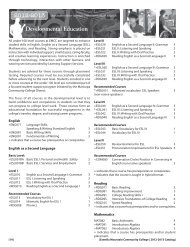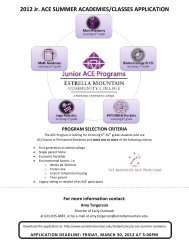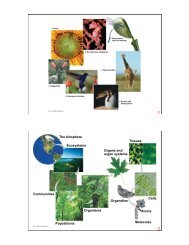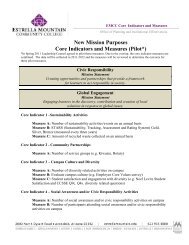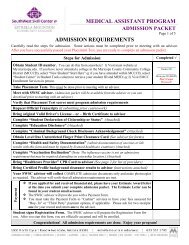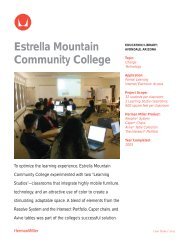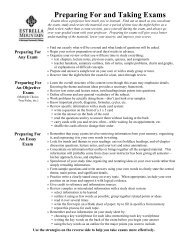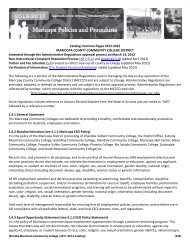Wavelength (nm) 400 450 500 550 600 650 700 L ig h t A b s o rb tio ...
Wavelength (nm) 400 450 500 550 600 650 700 L ig h t A b s o rb tio ...
Wavelength (nm) 400 450 500 550 600 650 700 L ig h t A b s o rb tio ...
You also want an ePaper? Increase the reach of your titles
YUMPU automatically turns print PDFs into web optimized ePapers that Google loves.
Copyr<strong>ig</strong>ht © The McGraw-Hill Companies, Inc. Permission required for reproduc<strong>tio</strong>n or display.<br />
Chloroplast<br />
Vascular bundle Stoma<br />
Vacuole<br />
Cell wall<br />
Inner membrane<br />
Outer membrane<br />
Courtesy Dr. Kenneth Miller, Brown University<br />
Cuticle<br />
Epidermis<br />
Mesophyll<br />
1.58 µm<br />
Copyr<strong>ig</strong>ht © The McGraw-Hill Companies, Inc. Permission required for reproduc<strong>tio</strong>n or display.<br />
0.001 <strong>nm</strong> 1 <strong>nm</strong> 10 <strong>nm</strong> 1000 <strong>nm</strong><br />
<strong>400</strong> <strong>nm</strong><br />
Gamma rays<br />
X-rays<br />
Increasing wavelength<br />
Visible l<strong>ig</strong>ht<br />
Increasing energy<br />
Infrared<br />
0.01 cm 1 cm 1 m<br />
Radio waves<br />
430 <strong>nm</strong> <strong>500</strong> <strong>nm</strong> 560 <strong>nm</strong> <strong>600</strong> <strong>nm</strong> <strong>650</strong> <strong>nm</strong> 740 <strong>nm</strong><br />
Porphyrin<br />
head<br />
UV<br />
l<strong>ig</strong>ht<br />
Copyr<strong>ig</strong>ht © The McGraw-Hill Companies, Inc. Permission required for reproduc<strong>tio</strong>n or display.<br />
H 2 C CH<br />
H 3 C<br />
H<br />
H 3 C<br />
H<br />
N N<br />
Mg<br />
N N<br />
H<br />
CO2CH3 O C<br />
O<br />
CH<br />
CCH3 CHCH3 CH2 CH2 CH2 CHCH3 CH2 CH2 CH2 CHCH3 CH3 O<br />
CH2 CH2 CH2 CH2 CH2 CH2 Hydroca<strong>rb</strong>on<br />
tail<br />
H<br />
H<br />
R<br />
Chlorophyll a: R = CH3 Chlorophyll b: R = CHO<br />
CH 2 CH 3<br />
H<br />
CH 3<br />
100 m<br />
1<br />
3<br />
5<br />
L<strong>ig</strong>ht<br />
Abso<strong>rb</strong><strong>tio</strong>n<br />
h<strong>ig</strong>h<br />
low<br />
Copyr<strong>ig</strong>ht © The McGraw-Hill Companies, Inc. Permission required for reproduc<strong>tio</strong>n or display.<br />
Photosystem<br />
Thylakoid<br />
Stroma<br />
Sunl<strong>ig</strong>ht<br />
ADP + P i<br />
CO 2<br />
L<strong>ig</strong>ht-Dependent<br />
Reac<strong>tio</strong>ns<br />
ATP<br />
H 2O<br />
Calvin<br />
Cycle<br />
NADP +<br />
O 2<br />
NADPH<br />
Organic<br />
molecules<br />
Copyr<strong>ig</strong>ht © The McGraw-Hill Companies, Inc. Permission required for reproduc<strong>tio</strong>n or display.<br />
carotenoids<br />
chlorophyll a<br />
chlorophyll b<br />
<strong>400</strong> <strong>450</strong> <strong>500</strong> <strong>550</strong> <strong>600</strong> <strong>650</strong> <strong>700</strong><br />
<strong>Wavelength</strong> (<strong>nm</strong>)<br />
Copyr<strong>ig</strong>ht © The McGraw-Hill Companies, Inc. Permission required for reproduc<strong>tio</strong>n or display.<br />
Oak leaf<br />
in summer<br />
Oak leaf<br />
in autumn<br />
© Eric Soder<br />
2<br />
4<br />
6
Energy of electrons<br />
Photon<br />
Chlorophyll<br />
molecule<br />
Excited reac<strong>tio</strong>n center<br />
Photon<br />
2 e –<br />
Photosystem II<br />
Copyr<strong>ig</strong>ht © The McGraw-Hill Companies, Inc. Permission required for reproduc<strong>tio</strong>n or display.<br />
Photosystem<br />
e –<br />
Electron<br />
donor<br />
e –<br />
Electron<br />
acceptor<br />
Copyr<strong>ig</strong>ht © The McGraw-Hill Companies, Inc. Permission required for reproduc<strong>tio</strong>n or display.<br />
2. The electrons pass through the b 6-f<br />
complex, which uses the energy<br />
released to pump protons across<br />
the thylakoid membrane. The proton<br />
gradient is used to produce ATP by<br />
chemiosmosis.<br />
e –<br />
2 Plastoquinone<br />
2<br />
e –<br />
b 6-f<br />
complex<br />
H 2O<br />
H +<br />
2H + + 1 / 2O2<br />
1. A pair of chlorophylls in the reac<strong>tio</strong>n center<br />
abso<strong>rb</strong> two photons of l<strong>ig</strong>ht. This excites two<br />
electrons that are transferred to plastoquinone<br />
(PQ). Loss of electrons from the reac<strong>tio</strong>n center<br />
produces an oxida<strong>tio</strong>n potential capable of<br />
oxidizing water.<br />
ADP + P i<br />
L<strong>ig</strong>ht-Dependent<br />
Reac<strong>tio</strong>ns<br />
Reac<strong>tio</strong>n<br />
center<br />
NADP +<br />
A T P<br />
Calvin<br />
Cycle<br />
PQ<br />
Proton gradient formed<br />
for ATP synthesis<br />
Plastocyanin<br />
PC<br />
Reac<strong>tio</strong>n center<br />
chlorophyll<br />
Thylakoid Thylakoid membrane membrane<br />
Excited reac<strong>tio</strong>n center<br />
2 e –<br />
Photosystem I<br />
2<br />
e –<br />
Reac<strong>tio</strong>n<br />
center<br />
Ferredoxin<br />
Fd<br />
NADP + + H +<br />
Photon<br />
Copyr<strong>ig</strong>ht © The McGraw-Hill Companies, Inc. Permission required for reproduc<strong>tio</strong>n or display.<br />
NADPH<br />
6 molecules of<br />
6 ADP<br />
6 ATP<br />
Ribulose 1,5-bisphosphate (5C) (RuBP)<br />
4 P i<br />
10 molecules of<br />
Glyceraldehyde 3-phosphate (3C)<br />
6 molecules of<br />
Ca<strong>rb</strong>on<br />
dioxide (CO 2 )<br />
Rubisco<br />
Calvin Cycle<br />
2 molecules of<br />
Glyceraldehyde 3-phosphate (3C) (G3P)<br />
Glucose and<br />
other sugars<br />
NADP<br />
reductase<br />
NADPH<br />
7<br />
3. A pair of chlorophylls in the reac<strong>tio</strong>n<br />
center abso<strong>rb</strong> two photons. This<br />
excites two electrons that are passed to<br />
NADP + , reducing it to NADPH. Electron<br />
transport from photosystem II replaces<br />
these electrons.<br />
12 molecules of<br />
3-phosphoglycerate (3C) (PGA)<br />
Stroma of chloroplast<br />
12 Pi 12 ATP<br />
12 ADP<br />
12 molecules of<br />
1,3-bisphosphoglycerate (3C)<br />
12 NADP +<br />
12 molecules of<br />
Glyceraldehyde 3-phosphate (3C) (G3P)<br />
12 NADPH<br />
9<br />
11<br />
L<strong>ig</strong>ht-Dependent<br />
Reac<strong>tio</strong>ns<br />
NADP<br />
ADP + P NADPH<br />
i ATP<br />
Stroma<br />
Calvin<br />
Cycle<br />
Copyr<strong>ig</strong>ht © The McGraw-Hill Companies, Inc. Permission required for reproduc<strong>tio</strong>n or display.<br />
e –<br />
+<br />
L<strong>ig</strong>ht<br />
e –<br />
Chlorophyll<br />
reduced<br />
Donor<br />
oxidized<br />
H 2O<br />
Water-splitting<br />
enzyme<br />
ADP + P i<br />
Thylakoid<br />
space<br />
e –<br />
–<br />
e –<br />
Electron<br />
donor<br />
Excited<br />
chlorophyll<br />
molecule<br />
e –<br />
+<br />
Electron<br />
acceptor<br />
Chlorophyll<br />
oxidized<br />
Acceptor<br />
reduced<br />
Copyr<strong>ig</strong>ht © The McGraw-Hill Companies, Inc. Permission required for reproduc<strong>tio</strong>n or display.<br />
Photon<br />
Thylakoid<br />
membrane<br />
2e –<br />
1 /2O2 2H+<br />
Antenna<br />
complex<br />
PQ<br />
Plastoquinone<br />
Photosystem II b6-f complex Photosystem I<br />
1. Photosystem II<br />
abso<strong>rb</strong>s photons,<br />
exciting electrons<br />
that are passed to<br />
plastoquinone (PQ).<br />
Electrons lost from<br />
photosystem II are<br />
replaced by the<br />
oxida<strong>tio</strong>n of water,<br />
producing O 2<br />
2e –<br />
H +<br />
Photon<br />
PC<br />
2. The b 6-f complex<br />
receives electrons<br />
from PQ and passes<br />
them to plastocyanin<br />
(PC). This provides<br />
energy for the b 6-f<br />
complex to pump<br />
protons into the<br />
thylakoid.<br />
2e–<br />
e –<br />
e –<br />
Plastocyanin Ferredoxin<br />
–<br />
e –<br />
+ NADP +<br />
H +<br />
Fd<br />
NADPH<br />
2e –<br />
NADP<br />
reductase<br />
3. Photosystem I abso<strong>rb</strong>s<br />
photons, exciting<br />
electrons that are<br />
passed through a<br />
carrier to reduce<br />
NADP + to NADPH.<br />
These electrons are<br />
replaced by electron<br />
transport from<br />
photosystem II.<br />
Copyr<strong>ig</strong>ht © The McGraw-Hill Companies, Inc. Permission required for reproduc<strong>tio</strong>n or display.<br />
Photo-<br />
system<br />
II<br />
Sunl<strong>ig</strong>ht<br />
O 2<br />
Heat<br />
ATP NADPH NAD NADH<br />
+<br />
NADPi Calvin<br />
Cycle<br />
Glucose<br />
Photo-<br />
system<br />
I<br />
ATP<br />
H 2 O<br />
CO 2<br />
Pyruvate<br />
Electron<br />
Transport<br />
System<br />
Krebs<br />
Cycle<br />
ADP<br />
Proton<br />
gradient<br />
H +<br />
H +<br />
H +<br />
H+<br />
ATP<br />
synthase<br />
ATP<br />
4. ATP synthase uses<br />
the proton gradient<br />
to synthesize ATP<br />
from ADP and P i<br />
enzyme acts as a<br />
channel for protons<br />
to diffuse back into<br />
the stroma using this<br />
energy to drive the<br />
synthesis of ATP.<br />
ATP<br />
ADP + P i<br />
ATP<br />
ADP + P i<br />
8<br />
10<br />
12
n<strong>ig</strong>ht<br />
day<br />
Mesophyll<br />
cell<br />
RuBP<br />
CO 2<br />
a. C 4 pathway<br />
Mesophyll<br />
cell<br />
Bundle-<br />
sheath<br />
cell<br />
Calvin<br />
Cycle<br />
G3P<br />
CO 2<br />
C 4<br />
CO 2<br />
Calvin<br />
Cycle<br />
G3<br />
b. C 4 pathway<br />
Copyr<strong>ig</strong>ht © The McGraw-Hill Companies, Inc. Permission required for reproduc<strong>tio</strong>n or display.<br />
3PG<br />
(C 3)<br />
Mesophyll cell Bundle-sheath cell<br />
Stoma<br />
Mesophyll cell<br />
Vein<br />
Stoma Vein<br />
a: © John Shaw/Photo Researchers, Inc. b: © Joseph Nettis/Na<strong>tio</strong>nal Audubon Society Collec<strong>tio</strong>n/Photo Researchers, Inc.<br />
CO 2<br />
C 4<br />
CO 2<br />
Calvin<br />
Cycle<br />
G3P<br />
Copyr<strong>ig</strong>ht © The McGraw-Hill Companies, Inc. Permission required for reproduc<strong>tio</strong>n or display.<br />
© ClydeH. Smith/Peter Arnold Inc.<br />
Bundle-<br />
sheath cell<br />
13<br />
15<br />
17<br />
Leaf<br />
epidermis<br />
H 2O<br />
Copyr<strong>ig</strong>ht © The McGraw-Hill Companies, Inc. Permission required for reproduc<strong>tio</strong>n or display.<br />
Heat<br />
Stomata<br />
H 2O<br />
Under hot, arid condi<strong>tio</strong>ns, leaves lose water by<br />
evapora<strong>tio</strong>n through openings in the leaves<br />
called stomata.<br />
CO 2<br />
O 2<br />
O 2<br />
CO 2<br />
The stomata close to conserve water but as a<br />
result, O 2 builds up inside the leaves, and CO 2<br />
cannot enter the leaves.<br />
Copyr<strong>ig</strong>ht © The McGraw-Hill Companies, Inc. Permission required for reproduc<strong>tio</strong>n or display.<br />
CO 2<br />
Mesophyll<br />
cell<br />
Phosphoenolpyruvate<br />
(PEP)<br />
AMP +<br />
PP i<br />
ATP<br />
+ P i<br />
Oxaloacetate<br />
Pyruvate Malate<br />
Pyruvate<br />
Bundle-sheath<br />
cell<br />
CO 2<br />
Calvin<br />
Cycle<br />
Glucose<br />
Malate<br />
14<br />
16




